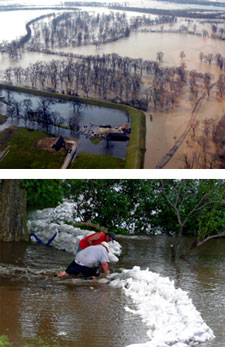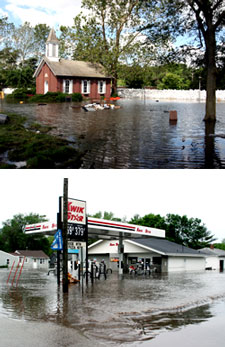Billions in damage as flooding uproots towns, crops and lives across the Midwest

(FinalCall.com) – Midwest floods are the latest weather phenomenon in a year that has already seen record tornadoes and heat waves. Though too early to predict, analysts say the cost of flood damage is likely to surpass the $21 billion losses of the Great Floods of 1993.
The Midwest floods of 2008, which started in early June and impacted 10 states, had claimed 24 lives and left 150 people injured at Final Call press time. News programs beamed pictures of distraught residents who watched their lives float away, homes get submerged and farmers who prepared to slaughter livestock they could not feed. Among states hit hard by the severe flooding have been Iowa, Wisconsin, Missouri, Illinois, Indiana and Nebraska.
The Red Cross reported June 23 that for the second time in 125 years, the organization is out of money and using loans to cover its operations. The Red Cross said it has 4,500 people on the ground in the Midwest and 2,000 employees monitoring disasters from its headquarters. The Midwest operation may cost $15 million, the Red Cross said.
Midwest residents also aren’t the only ones who will pay for a disaster some analysts called the Hurricane Katrina of the central part of the country, with levee failures and widespread destruction. Soon other parts of the country and global consumers will be paying more for feed, fuel and food, experts explained.
Flooding costs spread beyond Midwest
“Iowa is the number one producer of corn. Already one to two million acres of corn have been flooded or damaged and are in need of being replanted.This represents 25 percent of the cornfields. There will be higher prices for corn,” said Roger Elmore, professor of agronomy and corn specialist at Iowa State University. “More than half of the corn is used to feed livestock such as cows, chickens, pork and turkeys. Another 30 percent is used to produce ethanol and eight percent goes into food.It’s similar with soybeans about 1-2 million acres have been affected.Replanting is going on now.”
“These floods are more widespread in the state. They are impacting eastern Iowa and working their way to the southeast. They are fairly extensive. Last time they started July 13 this time they’re starting in June,” observed Dr. Dan Otto, an economics professor at Iowa State University. “The price impact will be greater this time too. We have far less grain in inventory this time.We’ve had record exports of corn this year to India and China.Costs have doubled over the past two years because of demand, now the costs will go up because of the floods.”
The U.S. Climate Change Science Program and the Subcommittee on Global Change Research released a report June 19 that provided the first comprehensive analysis of observed and projected changes in weather and climate extremes in North America and U.S. territories. It found droughts, heavy downpours, excessive heat, and intense hurricanes are likely to become more commonplace as humans continue to increase the “atmospheric concentrations of heat-trapping greenhouse gases.”
The report cites scientific evidence that a warming world will beaccompanied by changes in the intensity, duration, frequency,and geographic extent of weather and climate extremes.
Global warming of the past 50 years is due primarily to human-induced increases in heat-trapping gases, according to the report. Many types of extreme weather and climate event changes have been observed during this time period and continued changes are projected for this century.

“We have already seen more than 115 tornado-related deaths, making this the deadliest tornado season since 1998,” said Greg Carbin, a meteorologist at the National Oceanic Atmospheric Administration Storm Prediction Center in Norman, Okla.
“It is only the third time since the 1974 super tornado outbreak that there have been more than 100 tornado-related deaths during a single tornado season in the U.S.,” said Harold Brooks, a research meteorologist at NOAA’s National Severe Storms Laboratory also in Norman. “In 1998 and 1984 there were 132 and 122 tornado-related deaths, respectively–2008 will likely equal or exceed that record.”
Levees fail along the Mississippi River
As the Mississippi River overflowed its banks and levees designed to keep the lower Mississippi River from flooding failed, water swept through some parts of southern Illinois.
Juli Parks, of Gulfport, Ill., didn’t worry when water began creeping up the levee that shields this town of about 750 from the Mississippi River–not even when volunteers began piling on sandbags. Local officials had assured townspeople in 1999 that the levee was sturdy enough to withstand a historic flood, and FEMA had agreed. In fact, some relieved homeowners dropped their flood insurance, and others applied for permits to build new houses and businesses.
Then on June 17, the worst happened: The levee burst and Gulfport was submerged in 10 feet of water. Only 28 property owners were insured against the damage.
Around the country, thousands of residents who rely on risk maps from the Federal Emergency Management Agency may unknowingly face similar dangers.
“People put all their hopes in those levees, and when they do fail, the damage is catastrophic,” said Paul Osman, the National Flood Insurance Program coordinator for Illinois. “New Orleans is the epitome; a lot of those people didn’t even realize they were in a floodplain until the water was up to their roofs.”
Mike Buckley, a FEMA deputy assistant administrator, said agency officials encourage everyone to buy federal flood insurance and have never claimed that levees eliminate the risk of flooding.
Calculations on flooding outdated?
But now–amid the disastrous flooding across Iowa, Illinois and Missouri–some policymakers are demanding the government come up with more accurate, up-to-date flood-risk assessments, inform the public better of the dangers, and require nearly all homeowners to buy coverage if they live near dams or levees.
Some FEMA floodplain maps are 20-years-old and seriously outdated, based on old evaluations of levees and river conditions.
FEMA, which administers the National Flood Insurance Program, has spent almost $1 billion since 2003 so far to modernize its maps, which Mr. Buckley said are for insurance purposes, not to indicate people are safe. FEMA said it is up to Congress to decide whether everyone whose home could be swamped by a breach of a levee or dam should be required to buy flood insurance.
Larry Larson, executive director of the Association of State Floodplain Managers, said FEMA should not wait for Congress. But he said he doubts the agency will act on its own, because the move would be too politically unpopular.
At least 22 levees in three flood-stricken states already had been topped by floodwaters the week of June 13, according to the Army Corps of Engineers.
Federal Government response
President Bush visited the area June 19 and promised help from the federal government, which has sent more than $22 million in aid to the flooded area. Congress has inserted $2 billion for disaster relief in a new spending bill. Presidential hopefuls Barack Obama (D) and Republican John McCain toured flood-prone areas as volunteers frantically filled sandbags to shore up levees. Right-wing extremist talk show host Rush Limbaugh declared, “I look at Iowa, I look at Illinois–I want to see the murders. I want to see the looting. I want to see all the stuff that happened in New Orleans. I see devastation in Iowa and Illinois that dwarfs what happened in New Orleans. I see people working together. … I don’t see a bunch of people running around waving guns at helicopters, I don’t see a bunch of people running, shooting cops. I don’t see a bunch of people raping people on the street. I don’t see a bunch of people doing everything they can …whining and moaning where’s FEMA? Where’s Bush? I see the heartland of America.”
In Louisiana, Mo., the water was well above the banks of the upper Mississippi River June 22 but residents of nearby flooded towns and those protected by levees and sandbags could see the end in sight: The river was cresting. The river started cresting in Canton, Mo., not far from the Iowa state line, through the lock and dam near Quincy, Ill. Next up, according to federal forecasters, were crests expected June 23 from Hannibal to Clarksville, Mo.
Residents in Winfield and Grafton, Ill., were still waiting, as forecasters said the river would crest there on June 25. A reminder the threat had not passed came in Lincoln County, Mo., where a levee near Winfield overtopped and flooded about 1,000 acres and fewer than half a dozen homes.
“It just blew through our sandbags,” said Lincoln County emergency management spokesman Andy Binder.
“There are things we can do now to reduce floodplain risk, such as review all significant dams and levees for risks and public safety; increase the nation’s commitment to updating and improving floodplain maps, and incorporating future conditions and creating stronger zoning rules and increasing wetlands protections that can reduce flooding to keep people and homes safe,” said Mr. Schweiger.
“And many of our past solutions, such as basing predictions only on past flooding histories, instead of foreseeable future conditions and relying on levees that give occupants a false sense of security, must be rethought in light of increasing development and global warming.”
Dr. Gerald Galloway is also a U.S. Army Brigadier General. He testified before Congress after Hurricane Katrina flooded New Orleans and feels the same things he said then are true today.
“A flood catastrophe represents a national security issue .Floods especially attack the poor, the disabled and the elderly. They affect our people, our economy, and our environment. How to deal with them has been the subject of many studies over the years and we keep coming back to the same recommendations,” said Dr. Galoway.
“We need to take an approach to flood damage reduction that brings all of the players to the table in a collaborative approach that shares responsibilities and funding. The federal government, acting alone, may not be able to afford new projects but, where it already has been committed to provide protection and where it now provides protection, it has an obligation to provide an appropriate level of protection and to carry out the maintenance necessary to insure system integrity.”
(The Associated Press contributed to this report.)












